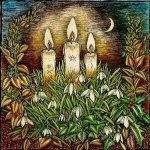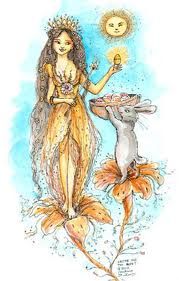Sunday is St. Patrick’s Day but Saturday is the big parade in NYC. The tradition on the day is corned beef and cabbage with potatoes, so what to eat on parade day. The easy answer is go traditional with a stew. This beef stew made with Guiness Stout and topped with a Stilton laced pastry crust takes a little work but it is well worth the work.
Ingredients:
* 7 Tbs. olive oil
* 1 lb. white button mushrooms, quartered
* 2 cups frozen pearl onions, thawed
* Salt and freshly ground pepper, to taste
* 3 1/2 lb. beef chuck roast, cut into 1-inch cubes
* 1 cup all-purpose flour
* 3 garlic cloves, minced
* 2 Tbs. tomato paste
* 2 1/2 cups Irish stout
* 1 cup beef broth
* 1 lb. carrots, cut into chunks
* 1 lb. red potatoes, cut into chunks
* 1 Tbs. finely chopped fresh thyme
* One 16-inch round Stilton pastry (recipe below)
* 1 egg, beaten with 1 tsp. waterDirections:
In a 5 1/2-quart Dutch oven over medium-high heat, warm 1 Tbs. of the olive oil. Add the mushrooms, onions, salt and pepper and cook, stirring occasionally, about 12 minutes. Transfer to a bowl.Season the beef with salt and pepper. Dredge the beef in the flour, shaking off the excess. In the Dutch oven over medium-high heat, warm 2 Tbs. of the olive oil. Add one-third of the beef and brown on all sides, about 7 minutes total. Transfer to a separate bowl. Add 1/2 cup water to the pot, stirring to scrape up the browned bits. Pour the liquid into a separate bowl. Repeat the process 2 more times, using 2 Tbs. oil to brown each batch of beef and deglazing the pot with 1/2 cup water after each batch.
Return the pot to medium-high heat. Add the garlic and tomato paste and cook, stirring constantly, for 30 seconds. Add the beef, stout, broth and reserved liquid, stirring to scrape up the browned bits. Add the mushrooms, onions, carrots, potatoes and thyme and bring to a boil. Reduce the heat to medium-low, cover and simmer, stirring occasionally, until the beef and vegetables are tender, about 3 hours.
Preheat an oven to 400°F.
Stilton Pastry
Ingredients:
* 2 1/2 cups all-purpose flour
* 2 tsp. salt
* 1 Tbs. sugar
* 16 Tbs. (2 sticks/250g) cold unsalted butter, cut into 1/2-inch pieces
* 1/3 to 1/2 cup ice water
* 4 oz. Stilton cheese, crumbledDirections:
In a food processor, combine the flour, salt and sugar and pulse until blended, about 5 pulses. Add the butter and process until the mixture resembles coarse meal, about 10 pulses. Add 1/3 cup of the ice water and pulse 2 or 3 times. The dough should hold together when squeezed with your fingers but should not be sticky. If it is crumbly, add more water 1 Tbs. at a time, pulsing twice after each addition. Turn the dough out onto a lightly floured work surface and shape into a disk. Wrap with plastic wrap and refrigerate for 1 hour.Remove the dough from the refrigerator and let stand for 5 minutes. Sprinkle the top of the dough lightly with flour, place on a lightly floured sheet of parchment paper and roll out into a 12-by-16-inch rectangle. Sprinkle the cheese over half of the dough, then fold the other half over the cheese. Roll out the dough into a 16 1/2-inch square. Using a paring knife, trim the dough into a 16-inch round.
Refrigerate the dough until firm, about 10 minutes, then lay the dough on top of the beef and stout pie and bake as directed in that recipe. Makes enough dough for a 16-inch round.
Brush the rim of the pot with water. Lay the pastry round on top, allowing it to droop onto the filling. Trim the dough, leaving a 1-inch overhang, and crimp to seal. Brush the pastry with the egg mixture, then cut 4 slits in the top of the dough. Bake for 30 minutes. Let the potpie rest for 15 minutes before serving. Serves 8 to 10.
Erin Go Bragh!

 Although you’d never know it if you looked out your window here in the Northeast and throughout a good part of the northern hemisphere, we are nearing the midpoint between winter solstice and the vernal equinox. The Sun is noticeably rising earlier and setting later. It is a pleasure to take my early morning shower in daylight and start dinner preparation with daylight still illuminating the kitchen. There are seed catalogs arriving in the mail which has me contemplating the flower beds, the herb garden and maybe this year some vegetables.
Although you’d never know it if you looked out your window here in the Northeast and throughout a good part of the northern hemisphere, we are nearing the midpoint between winter solstice and the vernal equinox. The Sun is noticeably rising earlier and setting later. It is a pleasure to take my early morning shower in daylight and start dinner preparation with daylight still illuminating the kitchen. There are seed catalogs arriving in the mail which has me contemplating the flower beds, the herb garden and maybe this year some vegetables.  The symbols are ewes and lambs since Imbolc is derived from a Celtic word, “oimelc”, meaning ewe’s milk. Many of the foods that are serves are lamb, cheese, poppyseed muffins, cakes and breads. Dishes are seasoned with bay leaves and dried basil.
The symbols are ewes and lambs since Imbolc is derived from a Celtic word, “oimelc”, meaning ewe’s milk. Many of the foods that are serves are lamb, cheese, poppyseed muffins, cakes and breads. Dishes are seasoned with bay leaves and dried basil. Non-Pagans celebrate February 2nd as Ground Hog’s Day, a day to predict the coming weather, telling us that if the Groundhog sees his shadow, there will be ‘six more weeks’ of bad weather. It actually has ancient roots, weather divination was common to Imbolc, and the weather of early February was long held to be a harbinger of spring. On Imbolc, the crone
Non-Pagans celebrate February 2nd as Ground Hog’s Day, a day to predict the coming weather, telling us that if the Groundhog sees his shadow, there will be ‘six more weeks’ of bad weather. It actually has ancient roots, weather divination was common to Imbolc, and the weather of early February was long held to be a harbinger of spring. On Imbolc, the crone  Spring officially sprang at 1:14 AM Eastern Daylight Time on Tuesday. Partially because this is a “Leap Year”, in some times zones the
Spring officially sprang at 1:14 AM Eastern Daylight Time on Tuesday. Partially because this is a “Leap Year”, in some times zones the 
 Although you’d never know it if you looked out your window here in the Northeast and throughout a good part of the northern hemisphere, we are nearing the midpoint between winter solstice and the vernal equinox. The Sun is noticeably rising earlier and setting later. It is a pleasure to take my early morning shower in daylight and start dinner preparation with daylight still illuminating the kitchen. There are seed catalogs arriving in the mail which has me contemplating the flower beds, the herb garden and maybe this year some vegetables.
Although you’d never know it if you looked out your window here in the Northeast and throughout a good part of the northern hemisphere, we are nearing the midpoint between winter solstice and the vernal equinox. The Sun is noticeably rising earlier and setting later. It is a pleasure to take my early morning shower in daylight and start dinner preparation with daylight still illuminating the kitchen. There are seed catalogs arriving in the mail which has me contemplating the flower beds, the herb garden and maybe this year some vegetables.
Recent Comments